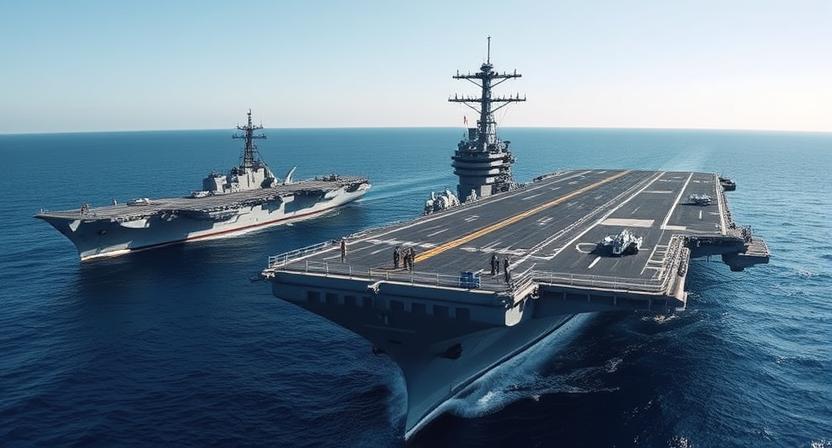Naval Warfare Strategy: Modern Approaches, Technology Integration, and Global Maritime Security

The Naval Warfare Strategy is central to the U.S. Navy’s ability to project power, safeguard maritime interests, and maintain global security. In an era of rapid technological change, evolving threats, and shifting geopolitical dynamics, modern naval strategy requires a comprehensive approach that integrates traditional maritime tactics with advanced technology, multi-domain operations, and adaptive leadership. This article explores the components, challenges, and innovations shaping contemporary naval warfare strategy.
Introduction: The Significance of Naval Strategy
Naval strategy is the foundation of maritime operations, providing a framework for deploying resources, responding to threats, and achieving strategic objectives. The modern battlefield extends beyond the open sea to include cyberspace, air, and space domains. Effective strategy ensures that naval forces maintain readiness, flexibility, and superiority against conventional and asymmetric threats.
Core Principles of Modern Naval Warfare
Modern naval warfare strategy is guided by several core principles:
-
Sea Control: Maintaining dominance over key maritime routes to ensure the free flow of trade and strategic mobility.
-
Deterrence: Preventing adversaries from challenging U.S. or allied naval power through credible and visible capabilities.
-
Force Projection: Leveraging naval assets to influence events ashore and demonstrate power globally.
-
Operational Flexibility: Adapting quickly to changing scenarios and multi-domain threats.
These principles provide the foundation for decision-making and operational planning.
Integration of Technology
Technology plays a transformative role in modern naval strategy. Key innovations include:
-
Artificial Intelligence (AI) and Machine Learning: Enhancing decision-making, threat detection, and predictive analytics.
-
Autonomous Systems: Utilizing unmanned vessels, drones, and robotic systems for reconnaissance, surveillance, and combat missions.
-
Cyber Operations: Protecting naval networks while enabling offensive cyber capabilities.
-
Advanced Weaponry: Implementing hypersonic missiles, precision-guided munitions, and integrated defense systems.
By leveraging technology, navies can respond more effectively to threats, increase operational efficiency, and reduce risk to personnel.
Multi-Domain Naval Operations
Modern naval strategy emphasizes coordination across multiple domains:
-
Sea: Traditional surface and subsurface warfare operations.
-
Air: Carrier-based aircraft, maritime patrol, and anti-submarine operations.
-
Cyber: Securing digital infrastructure, disrupting enemy networks, and gathering intelligence.
-
Space: Satellite communications, navigation, and surveillance supporting maritime operations.
Effective integration of these domains allows for rapid decision-making, operational adaptability, and strategic advantage.
Geopolitical Considerations
Global maritime security is influenced by geopolitical dynamics. Naval strategy must account for:
-
Tensions in the Indo-Pacific, particularly involving China and regional allies.
-
Security challenges in the Middle East, including strategic chokepoints and maritime trade routes.
-
Collaboration with NATO and allied naval forces to ensure interoperability and collective defense.
-
Monitoring emerging threats such as piracy, maritime terrorism, and gray-zone conflicts.
Strategic foresight allows navies to position forces effectively, anticipate potential conflicts, and maintain deterrence.
Leadership and Decision-Making
Effective naval strategy requires strong leadership capable of navigating complex operational environments. Commanders must combine operational experience with analytical insight, leveraging technology and intelligence to make informed decisions. Scenario planning, war-gaming, and rigorous training programs prepare leaders for rapid response to evolving threats.
Historical Lessons for Modern Strategy
Historical naval conflicts provide valuable lessons for contemporary operations. Key takeaways include the importance of logistics, intelligence, technological adaptation, and morale. Modern strategies incorporate these lessons to anticipate challenges, optimize resource deployment, and achieve operational success.
Cybersecurity and Information Warfare
Cybersecurity has become a critical element of naval warfare strategy. Protecting command and control systems, intelligence networks, and operational data is essential for maintaining strategic advantage. Information warfare, including electronic warfare and cyber disruption, is increasingly integrated into naval planning to neutralize adversary capabilities.
Environmental and Logistical Considerations
Naval operations require careful attention to environmental factors such as weather, sea conditions, and sustainability practices. Efficient logistics, supply chain management, and energy conservation are essential for prolonged deployments and operational readiness. Modern strategy emphasizes sustainability alongside mission effectiveness.
Future Outlook: Adaptive and Resilient Naval Strategy
The future of naval warfare strategy lies in adaptability, technological innovation, and international collaboration. Navies must remain agile, integrating emerging capabilities while anticipating new threats. Investment in research, training, and multi-domain operational readiness ensures that naval forces can maintain strategic dominance in an increasingly contested maritime environment.
Conclusion: Ensuring Global Maritime Security
The Naval Warfare Strategy reflects the evolving nature of modern military operations. By combining technological innovation, multi-domain coordination, geopolitical awareness, and ethical leadership, naval forces are positioned to maintain global security, protect critical sea lanes, and project power worldwide. A robust strategy ensures operational effectiveness, deters adversaries, and strengthens alliances, making it the cornerstone of modern maritime defense.
❓ FAQs
1. What is the purpose of naval warfare strategy?
The purpose is to guide the deployment of naval forces, maintain maritime dominance, ensure operational readiness, and achieve strategic objectives globally.
2. How does technology impact naval strategy?
Technology, including AI, autonomous systems, advanced weaponry, and cyber capabilities, enhances operational efficiency, decision-making, and threat response.
3. What are multi-domain operations?
Multi-domain operations involve coordinated efforts across sea, air, cyber, and space to achieve operational superiority and strategic flexibility.
4. How does geopolitical awareness influence naval strategy?
Understanding regional tensions, alliances, and emerging threats allows navies to position forces effectively, anticipate conflicts, and maintain deterrence.
5. What lessons from history inform modern naval strategy?
Historical conflicts emphasize the importance of logistics, intelligence, technology adaptation, and leadership, all of which inform contemporary naval planning.
- Art
- Causes
- Crafts
- Dance
- Drinks
- Film
- Fitness
- Food
- Giochi
- Gardening
- Health
- Home
- Literature
- Musica
- Networking
- Altre informazioni
- Party
- Religion
- Shopping
- Sports
- Theater
- Wellness


